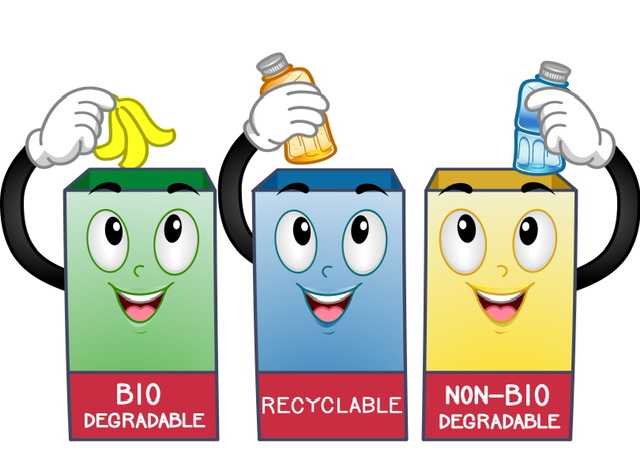We'll be back in a bit !
The system is currently undergoing a routine upgrade to ensure you get the best learning experience. The maintenance is expected to continue till 8:00 pm. Please check back later.
Thank you for your understanding!

The term "biodegradable" comes from the fusion of the terms "bio" and "degradable," and it describes materials that may be broken down or destroyed by bacteria or other organisms in the presence of oxygen and water without contributing to environmental degradation. Furthermore, it is considered that this biodegradation occurs spontaneously. Some examples of biodegradables are organic wastes, paper, wood, etc. A non-biodegradable material or thing cannot be broken down by the natural processes of bacteria, fungi, or any other living organism. Plastic, glass, metal, etc. are all instances of non-biodegradable materials.
Biodegradable materials are those that can be decomposed into simpler compounds by microorganisms, fungi, or animals. In contrast to mineral goods like glass, plastics, and metals, all animal and plant products are biodegradable. In contrast to composting, biodegradation (the biodegradable process) often happens spontaneously. And the breakdown of biodegradable materials is generally safe for the environment. While most biodegradable materials simply disappear into the soil, a small percentage of them decompose in a way that leaves behind chemicals or other toxins.
A few examples of Biodegradable materials are:
Animal byproducts
Food waste
Plant-based waste
To be considered biodegradable, a waste product must be made of an organic material that can be decomposed by microorganisms or other living things into carbon dioxide gas, water, methane gas, and other simpler organic molecules through processes like aerobic digestion (with oxygen present), anaerobic digestion (without oxygen present), compositing, and similar methods. It consists primarily or typically of organic materials from plants and kitchen scraps. Composting is only one way that biodegradable wastes are put to good use; they may also be converted into energy in the form of heat, electricity, or organic fuels.
Materials that cannot be decomposed into smaller, less harmful components by the activity of bacteria, fungus, or any other form of life are said to be non-biodegradable. Glass, plastic, and metal are only some examples of mineral or mineral products that are not biodegradable. They sit on Earth's surface for thousands of years without breaking down. Most non-biodegradable materials pose risks to human health or create various types of pollution during their disintegration. Plastic is one of the most frequent types of trash that won't break down in the environment. This necessitates the use of less dangerous materials.
A few examples of non-biodegradable materials are:
Plastic matter
Toxic gas
Metal waste
Waste disposal
Tossing out materials that can't be broken down by bacteria or fungi counts as non-biodegradable garbage. These wastes have a long-lasting impact on our ecosystem since they linger on the ground for thousands of years. Plastic is one of the most common forms of trash that won't break down in the environment. As it is inorganic, it does not break down naturally, leading to contamination of the land and water ecosystems. It also has a devastating effect on marine life. As a result, inorganic wastes of any form fall under the umbrella term of non-biodegradable waste.
Pollutants in the environment pose major threats to the health of local flora and wildlife. We generate waste whenever we use resources (food, water, energy, etc.) in inappropriate ways. One of the most harmful types of trash to the environment is plastic. Dioxins, furans, and other toxic gases are among those released when plastics are burned. The accumulation of plastics in the drainage system then prevents water from draining, creating an ideal environment for mosquitoes that may spread dengue. Other medical wastes pose a significant risk as well. Consuming these wastes causes intestinal blockage and ultimately death in animals like cows. Diseases and illnesses primarily originate from rubbish. Hence, a well-functioning waste management system is crucial to a prosperous society.
In one way or another, both biodegradable and non-biodegradable wastes are hazardous to the ecosystem.
Thus, there has to be waste treatment or management systems in place for the correct disposal of trash.
There are three main components to this therapy: recycling, reusing, and reduction.
These are the most fundamental measures that any community may take to eliminate waste and pollution.
Separating biodegradable and non-biodegradable materials before disposal is another vital step that everyone may do at home.
Biodegradable materials are those that can break down into smaller pieces when exposed to microbes or other forms of life, whereas non-biodegradable materials cannot be decomposed into smaller pieces when exposed to the activity of microorganisms or other forms of life.
Organic wastes, which are included in the category of biodegradable wastes, break down quickly and readily. Plastics and glass are two examples of non-biodegradable trash that require thousands of years to break down. Waste of any form is detrimental to the health of the planet and all its inhabitants. Hence, trash treatment, which entails recycling, reusing, and decreasing, is crucial.
A biodegradable material takes about 3-6 months to decompose. Organic micro bacteria decompose the waste material through their secretions, Thus, the process is a little long. Bio degradation also takes place through weathering.
Problems with sewage, an increase in the number of illnesses and diseases, and the extinction of animals and fisheries are only some of the negative consequences that waste materials can cause.
The "3 R's" of recycling—Recycle, Reuse, and Reduce—are a visual representation of this concept. Avoid unnecessary material waste by recycling and reusing items wherever feasible. Among the three "R"s, the most important is "Reduce," which refers to cutting down on trash in the first place.
